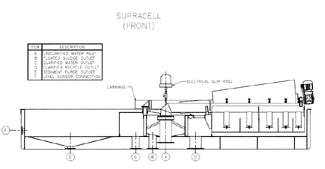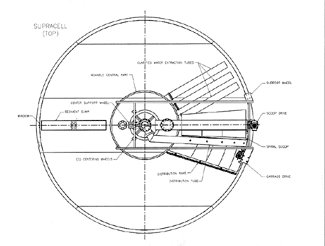Supracell DAF
The Krofta Supracell is a state-of-the-art DAF water clarification system used in thousands of applications worldwide. Its features a high output, very low retention time, and compact, space saving design (the Supracell's footprint is smaller than that of other systems of similar capacity).

The Krofta Supracell is recommended for cases in which the characteristics of the wastewater are variable. It has been applied to diverse segments including municipal wastewater, algae removal, packing houses, food processing plants, bakeries, laundries, chemical processing plants, oil removal, pulp and paper process, and effluent streams.
Supracell Operation
As a rotating carriage at the top of the unit travels in one direction, untreated water flows into the unit in the opposite direction. The two opposing forces equalize each other, creating 'zero-velocity' within the flotation cell. Zero velocity allows suspended solids (that have attached to microscopic air bubbles created by the Air Dissolving Tube (ADT) and pressure release valve) to freely rise to the surface. Effluent extraction pipes draw clarified water off of the bottom of the tank, depositing it into a common clearwell where it is discharged, by gravity, through the base of the unit. Floated sludge is removed by the spiral scoop and deposited out a central sludge well. A portion of the clarified water is recycled through the ADT and introduced back into the raw water stream to facilitate the flotation.

Air Dissolving Tube (ADT)
A portion of the clarified water, typically 20%, is recycled to feed the air dissolving system. A standard centrifugal pump draws clarified water from its source into the ADT, where it has an 8-12 second retention time. A uniquely designed influent nozzle causes the flow from the recycle pump to enter the ADT in a spiraling pattern. Compressed air, injected across the surface of a panel located inside the ADT, is dispersed evenly throughout the tube. The air mixes with the recycle water stream and is dissolved. A "bleed-off" mechanism prevents too much air from being introduced into the recycle stream, as this could cause air binding in the tube (the formation of coarse air/large air bubbles). The pressurized flow is fed through an inlet header, where it ultimately mixes with the raw water. A globe valve, located on the discharge line, controls the flow. Flow through the tube can be readily gauged by the difference in pressure from the inlet nozzle to the center of the tube. Krofta provides the valves, gauges, rotometers, site tube, and safety relief valves for this system. The ADT does not usually qualify as a pressure vessel so it is not subject to ASME coding or annual certification.
Capacities and Models
The Supracell is available in 20 standard sizes ranging from 4' in diameter up to 70' in diameter, cost-effectively processing flows from 5gpm to 12,000 gpm. If space is an issue, units can be easily stacked on top of each other for a smaller footprint.
Material of Construction
All wetted parts on the Supracell are constructed of 304L stainless steel; 316 stainless steel is an option. On units under 12' in diameter the entire unit, including the carriage assembly, is stainless steel. On units in excess of 12' in diameter, carriage assemblies and substructures may optionally be fabricated in mild steel and then painted with an epoxy coating.
Features and Advantages:
- There is generally only 18"-22" of water in the clarifier, affording the unit a very low floor loading.
- Units typically weigh 160 pounds/sf of less.
- The shallow tank design provides for easy tank inspection and cleaning.
- A viewing window mounted on the side of the tank facilitates observation of the flotation process and assists in optimizing chemical dosing (if necessary).
- The shallow, open tank design makes the unit ideal for installation on a wide variety of applications.
- Because all inlet and outlet connections are on the bottom of the unit, it can be installed in an elevated position. This is beneficial when draining the clarified water or floated sludge by gravity, eliminating the need for an additional pumping stage.
- The spiral scoop mechanism affords precise sludge removal by 'biting' into only the sludge layer, avoiding the clarified water. This increases floated sludge consistency, benefiting downstream sludge handling equipment by reducing flow and chemical consumption on the press.
- An automatic level control system monitors flow flocculations and can keep the level in the tank accurate within 1/4" to 1/2" to ensure consistent and precise sludge removal.
- Stainless steel construction.
- May be stacked for smaller footprint.
